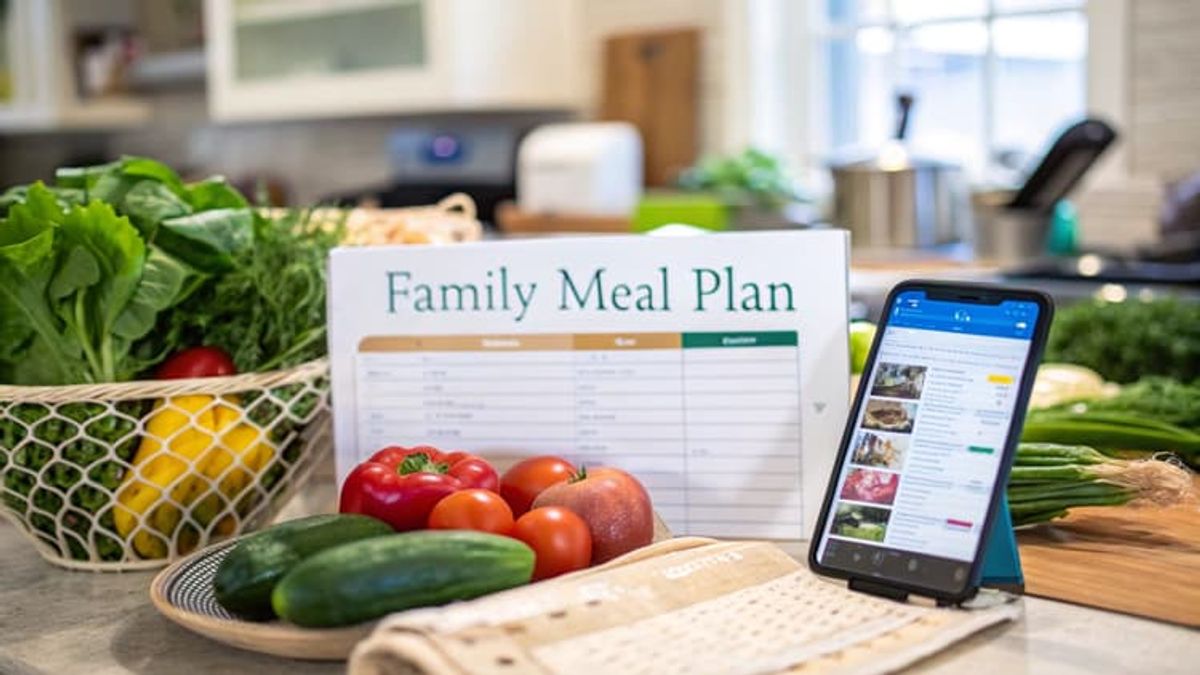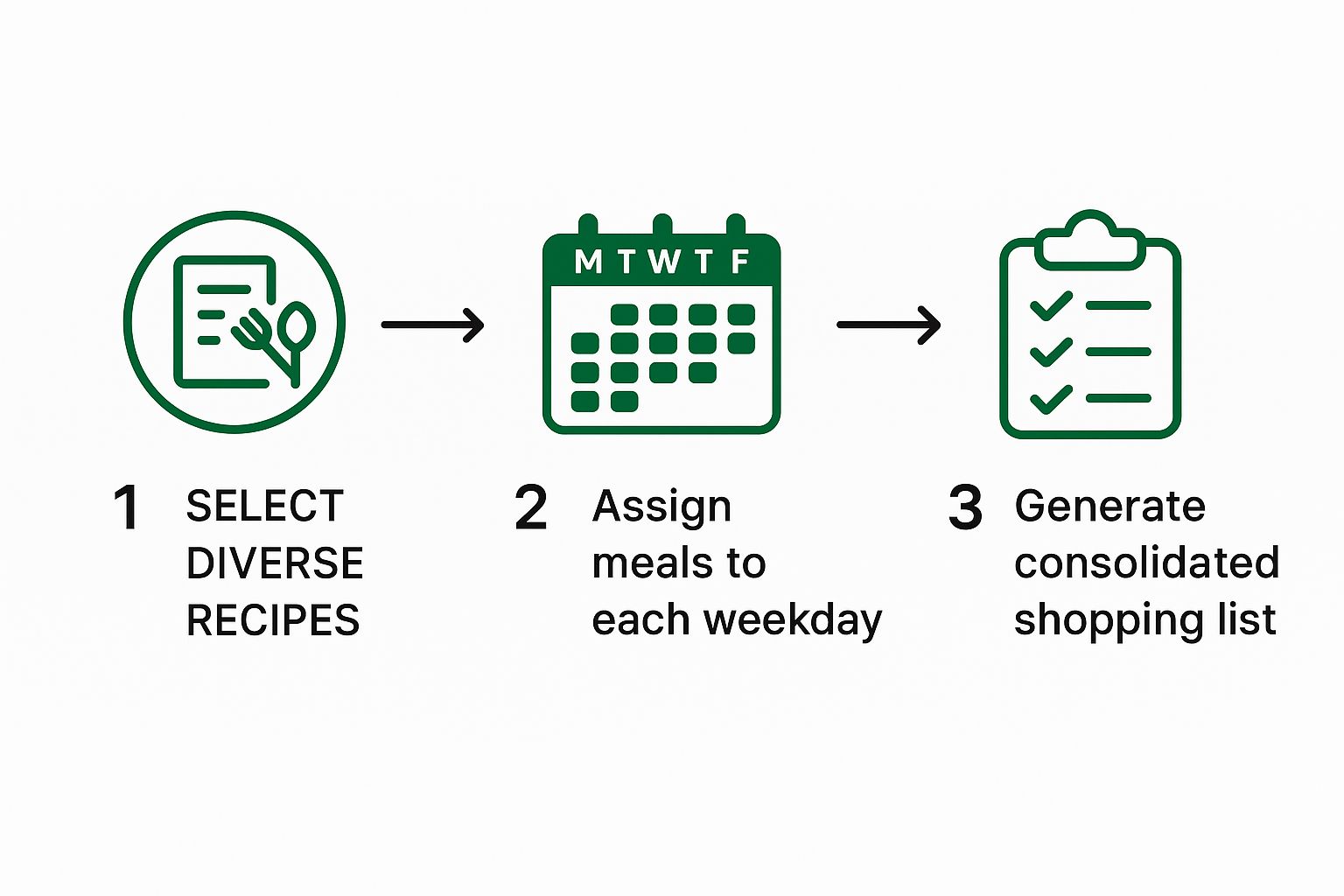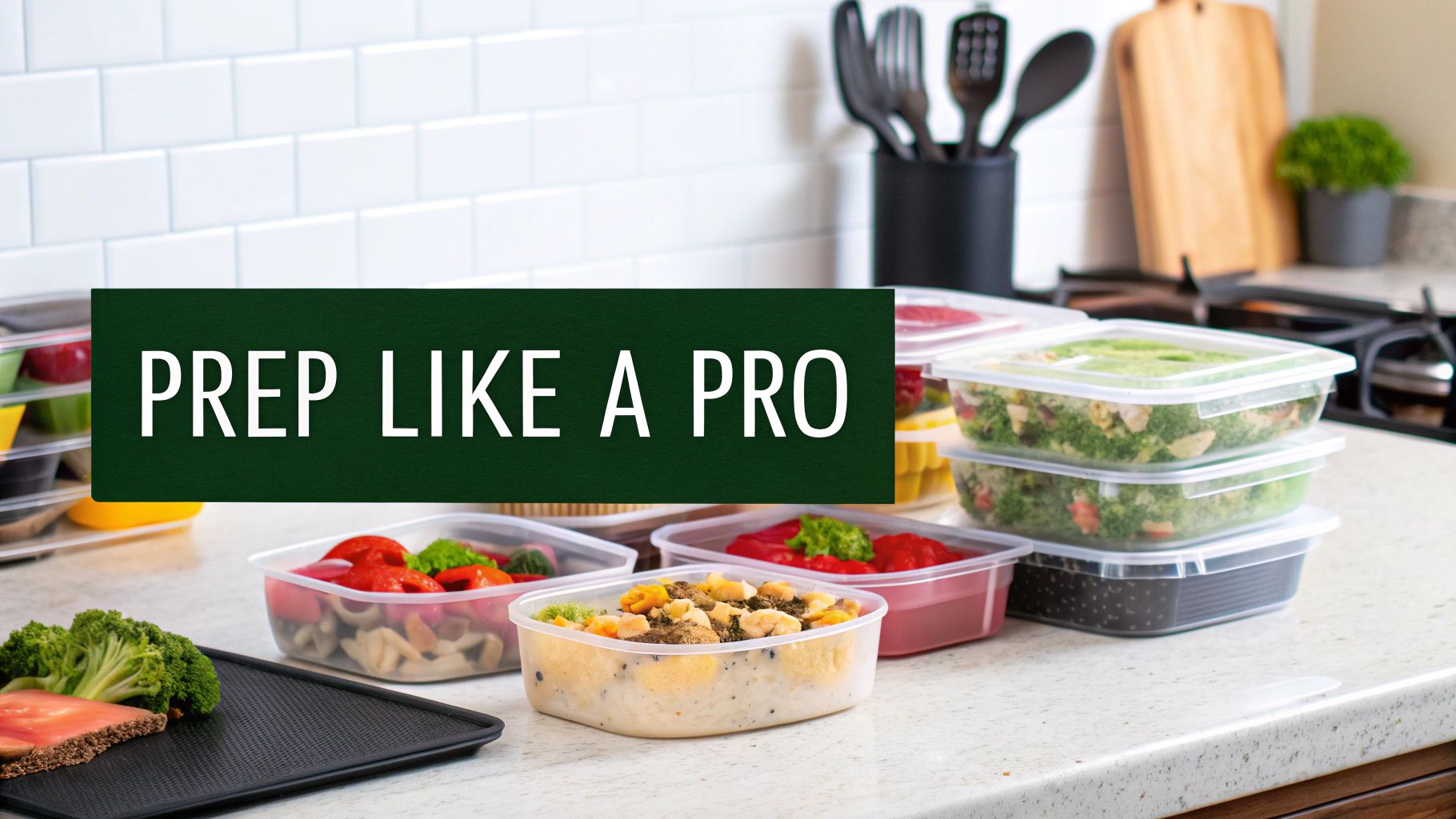Effective Meal Planning for Families: Tips to Simplify Your Week
Discover practical meal planning for families to save time, reduce stress, and enjoy nutritious meals together. Start simplifying your week today!
Love This Article?
Get personalized meal plans with recipes like this, automatically matched to your nutrition targets.

Effective Meal Planning for Families: Tips to Simplify Your Week
Let’s face it: effective meal planning is the ultimate superpower for any busy family. It's your secret weapon for a calmer week, saving you a ton of cash, cutting down on food waste, and finally putting an end to that dreaded daily question: "What's for dinner?!"
This isn't about creating some rigid, soul-crushing schedule. It’s about building a simple, flexible framework that actually brings the joy back to family dinners without stealing hours of your precious time. I'm going to show you exactly how to do it.
End the 5 PM Scramble for Good

We've all been there. That frantic 5 PM scramble, staring into the abyss of the refrigerator, desperately trying to pull a healthy, kid-approved meal out of thin air. It’s a universal parenting nightmare. The real killer isn't just the cooking; it's the sheer mental exhaustion of making one more decision at the end of a long day.
This is where we call it quits on the panic. Let's start thinking of meal planning not as a chore, but as a brilliant act of kindness to your future self.
A simple, flexible plan can completely turn your weeknights around. It’s the ticket to transforming chaotic evenings into actual moments of connection. Just imagine knowing exactly what’s on the menu each night, having all the ingredients ready to go, and freeing up enough mental space to actually listen to your kid's story about what happened at recess.
Reclaiming the Family Dinner
As parents, we know deep down how important shared meals are, but modern life has a knack for getting in the way. It’s a real struggle. In fact, research shows that while families eat together 33% less often than they did just two decades ago, a whopping 62% of parents wish they could share more family dinners. The main culprit? You guessed it—hectic schedules. You can dive deeper into these trends and the importance of family meals over at TheScramble.com.
This guide is here to help you bridge that gap. We're going to build a simple system to help you win back that precious time. Think of it as more than just a list on the fridge; it's a full-blown strategy for a better week.
- You'll save money by planning around sales and using up what you already own.
- You'll reduce food waste—that head of broccoli in the crisper drawer finally has a purpose!
- You'll slash your stress levels by killing off last-minute decisions and emergency grocery runs.
- You'll boost family connection by creating a consistent and positive routine around the dinner table.
By taking just a few moments to plan, you aren't just organizing meals. You are actively designing a more peaceful and connected week for your entire family. It's an investment that pays you back in time, money, and sanity.
Forget any notion that you need a culinary degree or a wide-open schedule to pull this off. The secret to success is a simple, repeatable system that actually fits your family's unique rhythm. We’ll walk through how to build a blueprint that bends with your life, from late soccer practices to those evenings when everyone is just too tired to function. This whole approach is about making your life easier, not adding another complicated task to your plate.
To get started, it helps to see the big picture. This simple framework breaks the entire process down into manageable chunks, so you know exactly where to begin.
Your Family Meal Planning Kickstart Framework
| Phase | Goal | Key Action |
| Assessment & Prep | Understand your family's needs and schedule. | Take stock of your pantry, check your calendar for busy nights, and involve the family in brainstorming ideas. |
| Recipe Curation | Find meals everyone will actually eat. | Gather 5-7 go-to recipes that are quick, reliable, and fit different dietary needs or preferences. |
| Plan & Shop | Create the weekly plan and get your ingredients. | Assign recipes to specific days, build your shopping list, and get everything you need in one efficient trip (or click). |
| Execution & Flex | Cook with ease and adapt when needed. | Follow your plan, but don't be afraid to swap days or have a backup "emergency meal" for chaotic evenings. |
With this framework in mind, you're not just winging it anymore—you're working a system. A system that will save your sanity, one dinner at a time.
Get Real With a Family Food Audit

Before you fall down a Pinterest rabbit hole of beautiful, complicated recipes, let's hit the brakes. The secret to meal planning that actually works isn't about lofty goals; it's about getting brutally honest with what your family really eats.
This is what I call the Family Food Audit. It’s a totally judgment-free exercise where you figure out your family’s true food personality. No shame allowed.
Think of it like creating a "Greatest Hits" playlist for your dinner table. Grab a notebook or pop open a new note on your phone. Your mission, should you choose to accept it, is to list every single meal that gets a thumbs-up from your people. Don't censor yourself! If "buttered noodles with a side of questionable parenting" makes a regular appearance, it goes on the list.
This master list is about to become your new best friend. Seriously. It’s the bedrock of every successful weekly plan you'll ever make.
Create Your Master Meal List
To make this audit truly useful, you need to sort your ideas into a few simple categories. We’re not aiming for a Dewey Decimal System of dinner here—just enough structure to save you from that dreaded 5 PM brain freeze. A little organization now prevents a lot of panic later.
Start by creating these categories and aiming for 3-5 meals in each:
- 15-Minute Miracles: These are your weeknight lifesavers. Think scrambled eggs and toast, quick quesadillas, or that box of mac and cheese you always have stashed away for emergencies.
- Reliable Rotations: Your solid, crowd-pleasing dinners. The ones you could probably make in your sleep. For our family, this means spaghetti with a good jarred sauce, sheet pan sausage and veggies, and taco night.
- Weekend Wonders: These are the meals that might take a bit more time but are totally worth the effort. Things like homemade pizza, a Sunday pot roast, or a big batch of chili.
The point isn't to curate a Michelin-star menu. It’s to build an arsenal of go-to meals you know won't start a dinner-table riot. This list is your secret weapon against the blank-slate panic of an empty meal plan.
Navigating the Picky Eater Predicament
And now, for the final boss of family mealtime: the picky eater. We’ve all been there. But the trick isn’t to become a short-order cook juggling three different meals. It’s all about clever deconstruction.
Think in components, not completed dishes. A "build-your-own" night is your best friend here. Whether it's tacos, rice bowls, or pasta bars, you set out a base everyone agrees on and let them customize from there. One kid might pile on chicken and cheese, while the other sticks to black beans and corn. Everyone is eating the same "meal," but it's tailored to their tastes.
My golden rule? Always include one "safe" food on the table. This is something you know your picky eater loves, like a side of their favorite fruit, some plain bread rolls, or a scoop of cottage cheese. It takes all the pressure off the main course and dramatically cuts down on the dinner-time drama. This tiny shift has been a game-changer for keeping the peace at our table.
Let's Sketch Out Your Weekly Blueprint
Alright, you've done the hard part and finished your Family Food Audit. Now you're sitting on a goldmine—a list of meals your family actually likes. The next step is to transform that list from a bunch of ideas into a real, honest-to-goodness plan for the week.
But hold on. We're not creating some rigid, military-style schedule here. A successful family meal plan has to be flexible. It needs to bend when life throws a curveball, not shatter into a million stressful pieces. The whole point is to build a framework that guides you, but still has room for a last-minute soccer practice or one of those nights where you'd rather do anything but cook.
Give Themed Nights a Shot—They’re a Game Changer
One of the easiest ways I’ve found to get started is with themed nights. It sounds almost too simple, but it’s a brilliant trick for cutting down on decision fatigue. You're no longer staring into the fridge wondering what on earth to make; you're just picking a dish that fits the theme.
Your week could look something like this:
- Meatless Monday: A great excuse for some hearty bean chili, veggie lasagna, or those black bean burgers everyone loves.
- Taco Tuesday: Is there a more perfect themed night? I don't think so. It's fun, everyone can build their own, and it's always a winner.
- Wacky Wednesday: This is your free space! Think breakfast-for-dinner, trying out a brand new recipe, or a "use up all the veggies" stir-fry.
- Pasta Thursday: Time for classic spaghetti and meatballs, a creamy chicken alfredo, or a light and easy pasta primavera.
- Pizza Friday: Kick off the weekend right. Whether it's homemade or from your favorite local spot, it’s the perfect end to the week.
This little visual shows you how making a few decisions upfront creates a simple, efficient flow that ends with a ready-to-go shopping list.

When you see it mapped out, it’s clear how a little structure early on makes everything else—especially the grocery run—so much smoother.
Get Smart with the "Cook Once, Eat Twice" Mindset
Here's another strategy that will seriously change your life: the "cook once, eat twice" philosophy. And no, I'm not talking about just reheating sad, soggy leftovers. This is about being clever and cooking bigger batches of components that you can spin into totally different meals later.
By thinking a step ahead, you can make one cooking session the base for two or three unique dishes. It’s an incredible way to slash your time in the kitchen and cut down on food waste.
Let's play this out. Say you roast a whole chicken on Sunday. Easy enough. On Monday, you can shred the leftover meat for some killer chicken tacos. Then on Tuesday, you use the bones to make a rich, comforting chicken noodle soup. Boom. Three completely different meals from one main cooking effort. That’s how you win back your weeknights.
Time to Build Your Grocery List—The Smart Way
Alright, you've got your beautiful, flexible meal plan ready to go. Now comes the moment of truth: turning those meal ideas into a shopping list that won't make your wallet cry. This is where all that planning really starts to pay off. Say goodbye to aimlessly wandering the aisles, tossing random (and expensive) impulse buys into your cart.
The mission is simple: get in and out of the grocery store with tactical precision. You'll save time, you'll save money, and you'll save your sanity. The secret weapon? A shopping list that’s organized for your store.
This is my favorite pro tip, and it’s a total game-changer. I organize my list based on my local store's layout because I know that place like the back of my hand. I group everything by section: produce first, then I swing by the meat and dairy coolers, hit the dry goods in the middle aisles, and finish up in the frozen section. No more frantic backtracking for that one forgotten onion. It keeps me focused and on a mission.
Ditch the Pen and Paper—Let a Robot Do the Boring Stuff
Let’s be honest, manually writing down every single ingredient for 5-7 different meals is a soul-crushing chore. This is where I lean on a little bit of modern magic. A tool like Meal Flow AI is an absolute lifesaver here. Instead of squinting at recipes and scribbling down a list, you can generate the whole thing with a single click.
Seriously, it’s an incredible time-saver. It’s also your secret weapon against forgetting that one crucial ingredient for tonight's dinner. The system is smart enough to group all the items together, turning what used to be a 30-minute task into a 30-second breeze.
A great meal plan is pointless if you don't follow through. By turning your weekly blueprint into an organized, automated shopping list, you remove that final hurdle between planning and actually cooking. Suddenly, your grocery run is faster, cheaper, and way less of a headache.
You can see just how much families crave this kind of help by looking at the explosion of meal kit services. The number of people using them more than doubled, jumping from 9.4 million in 2017 to a whopping 21.4 million by 2022. It’s a clear sign that modern families are done with the "what's for dinner?" scramble. If you're curious, you can read more about these trends in meal delivery services on Scoop.Market.us.
Outsmart the Aisles and Protect Your Budget
Having a list is one thing. Actually sticking to it is a whole other battle. Grocery stores are designed by geniuses of temptation to make you spend more. Here’s how you fight back and win.
- Spot the Real Deals: Don't get hypnotized by every bright yellow "SALE!" tag. Is it a genuine discount on something you actually need? Or is it a BOGO deal on unicorn-flavored chips your kids will eat once and forget? A great deal is only great if it’s on your list.
- Never, Ever Shop Hungry: This is the golden rule for a reason. A growling stomach is the worst shopping companion—it makes those checkout-lane candy bars look like a five-star dessert. Have a quick snack before you head out the door.
- Hug the Walls: Most of the good stuff—fresh produce, meat, dairy, and eggs—lives on the perimeter of the store. The processed, pricey, and less-healthy items are usually lurking in those long center aisles. The less time you spend there, the more money stays in your pocket.
Win Your Weeknights with Smart Prep

Let's get one thing straight. Meal prep doesn't mean chaining yourself to a hot stove all day Sunday. Not even close. The secret to actually making it work is what I call "component prepping." It's the ultimate high-five to your future, frazzled self and a total game-changer for anyone doing meal planning for families.
Instead of cooking five entire meals from start to finish, you're simply knocking out the small, tedious tasks ahead of time. You're breaking down your recipes into their most basic, and frankly most annoying, parts and tackling them whenever you find a spare pocket of time.
Picture it: It's Sunday afternoon. You've got a podcast playing and you spend maybe an hour chopping all the onions, dicing the peppers, and slicing the carrots for the week. While you're at it, you whisk together the marinade for Wednesday's chicken and get a big batch of quinoa bubbling on the stove. That single hour just saved you from the "what's for dinner?" panic and the drudgery of chopping on three different weeknights. It’s genius.
Turn Prep Time into Connection Time
Meal prep doesn’t have to be a lonely chore. In fact, it’s one of the best low-pressure ways to get your family into the kitchen with you. Turning a bit of prep into family time doesn't just lighten your load—it teaches your kids skills they'll actually use.
Even the littlest hands can get in on the action. It's a huge confidence booster, and you'll be shocked at how much more willing they are to eat something they helped make.
- Smoothie Superstars: Let them stuff freezer bags with their own smoothie creations. They can grab handfuls of spinach, plop in a scoop of yogurt, and toss in their favorite berries.
- Taco Team: Put one kid on cheese-grating duty, another on washing lettuce, and let the oldest mash up avocados for a killer guacamole.
- Snack Station Managers: Have them portion out nuts, crackers, or trail mix into little containers. Boom—grab-and-go snacks for the week are done.
The goal isn't a perfectly prepped kitchen; it's participation. When you invite your family into the process, you're turning a boring task into a moment of connection. You're not just prepping food—you're making memories.
The Magic of "Build-Your-Own" Dinners
This is where your component prep really shines. Setting up "build-your-own" dinner stations is the number one strategy for pleasing everyone at the table without feeling like a line cook. You lay out all the healthy, prepped building blocks, and everyone becomes their own head chef.
So, on Monday, that chicken you marinated and those veggies you sliced become an epic fajita bar. Come Thursday, the quinoa you cooked on Sunday is now the base for custom power bowls. Everyone gets a dinner they're excited about, and you get to enjoy a drama-free meal.
This simple shift makes meal planning for families feel way less like work and a whole lot more like play.
Answering Your Biggest Meal Planning Headaches
Alright, let's get real. Even the most organized meal planner hits a wall sometimes. Whether it's a rebellion at the dinner table or a week that goes completely sideways, these little hurdles can make you want to throw in the towel.
Don't sweat it. I've been there, and I’ve pulled together answers to the most common frustrations I hear about. Let's work through them together.
"Help! My Kid Won't Eat Anything. How Do I Stop Being a Short-Order Cook?"
Ah, the classic picky eater dilemma. This is hands-down the biggest challenge for most families, but the answer isn't to start making three different dinners every night. The magic trick? Deconstructed meals.
Think about a taco bar. You lay out all the components—tortillas, seasoned meat, different veggies, cheese, salsa—and everyone builds their own. It gives kids a sense of control. The key is to always include at least one "safe" food you know they’ll eat, whether it’s plain rice, some good bread, or their favorite raw veggie sticks.
Here's the one rule that saves your sanity: they don't have to eat it, but a tiny "tasting portion" of the new stuff has to go on their plate. No pressure, no battles. Over time, that exposure works wonders. Stick to your guns on this one—consistency is what keeps you out of the personal chef business.
"How Can I Possibly Meal Plan When My Budget Is Super Tight?"
Meal planning isn't a luxury; it's a financial superpower. If you're watching every penny, the first and most important step is to "shop" your own kitchen. Seriously. Before you even think about recipes, take a full inventory of your pantry, fridge, and freezer. Build your first couple of meals around what you already have on hand.
From there, it's all about strategy.
- Make your ingredients work overtime. Bought a big bag of carrots? Great. Plan on using them in a soup, roasting them as a side dish later in the week, and maybe even shredding the last few into a stir-fry.
- Go meatless once or twice. Swapping in a few dinners built around cheap, powerful proteins like beans, lentils, or eggs can dramatically slash your grocery bill.
- Turn dinner into lunch. Intentionally planning for leftovers is one of the quickest ways to stop spending money on workday lunches. Cook once, eat twice!
"My Schedule Is a Total Mess. A Strict Plan Will Never Work for Me."
You're right, it won't! For those of us with chaotic schedules, a rigid "Tuesdays are for Tacos" plan is doomed from the start. The secret is to embrace flexibility.
Instead of assigning meals to specific days, just create a master list of 5-7 meals you'd like to make that week. Then, each morning (or the night before), you can take a quick look at the day ahead and decide which meal actually fits. Crazy day full of errands and practice? That’s a job for the 15-minute pasta dish. A quieter evening at home? Perfect, let’s tackle that roast chicken.
It's about having a curated list of options, not a strict set of rules. Also, always keep one or two "emergency" meals in the freezer—like a frozen pizza or pre-made soup—for days when the plan goes completely off the rails.
"Is It Really That Big of a Deal if We Don't Eat Together?"
Honestly? Yes, it is. And it goes way beyond just getting calories in. In a world that’s constantly pulling us in a million different directions, the family dinner table is a grounding ritual. It’s our daily chance to actually connect.
Modern life has made eating alone surprisingly common—by 2023, one in four Americans ate by themselves daily, a whopping 53% increase since 2003. Yet, study after study confirms that eating together boosts happiness and makes families feel closer. You can dig into the research on this over at The Family Dinner Project.
Even if you can't manage it every single night, making it a priority reinforces a powerful idea: meal planning for families isn't just about feeding people. It's about intentionally carving out time to be a family.
---
Ready to stop stressing and start cooking? Meal Flow AI can whip up a personalized meal plan and a ready-to-go Instacart shopping list in seconds. Take back your weeknights and give it a try at https://mealflow.ai.